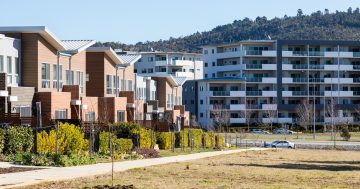
Denser housing will become more prevalent. Photo: Michelle Kroll.
The Housing Accord and other associated measures announced in the Budget have their critics, but at least it announces the Federal Government is getting back into the housing game after decades of neglect.
The problem has grown so huge, particularly as wages have gone backwards and property prices and rents have skyrocketed, that it can no longer be ignored.
Labor has already promised 30,000 affordable homes through its $10 billion Housing Australia Future Fund, and on Budget night committed to a further 10,000 through the Accord, matched by the states.
But most of the million homes over five years pledged with the Accord won’t be affordable. In fact, as many have pointed out, 200,000 properties a year are usually built anyway.
But the other aspects of the plan offer hope that it will make a difference.
Homes are meant to be “well-located” or sited close to where people work to help with the gruelling commutes many face. That may translate to homes around transport nodes, including light rail in Canberra.
Regional towns are also in urgent need of more housing as tree changers from the cities look for more value and quality of life in the country.
The Accord also commits the states and territories to look at zoning and planning policies to free up land for housing.
That’s an area the housing industry has consistently pursued in its campaign for help to boost supply.
While some will rightly worry about a development free-for-all, delays are all too evident in getting new housing off the ground, and good design should not have to be sacrificed.
It will mean densification – a contentious subject – because many of these homes, especially the affordable ones, will be apartments or townhouses, and wealthy enclave suburbs will resist.
Finally, Labor is hoping the private sector will bankroll much of this new housing, particularly institutional investors and the cashed-up superannuation industry.
Unlocking that money would be a significant achievement, but it will require a subsidy to make the affordable and build-to-rent component commercially viable.
The ACT – with the second highest house prices and highest rents in the country, something only tempered by high average wages – has understandably welcomed the Accord with open arms, and Chief Minister Andrew Barr has already said the Territory would be asking for more than a per capita share.
That is a tacit admission the current supply of housing, including the government’s public housing renewal program, is not enough to meet demand or reduce rents.
While boosting supply, in general, may eventually cool prices and rents, all governments must remember where the direst need is – low-income workers and those on fixed incomes.
The Federal Government will still need to pay for more public and social housing like it used to.
It may be good politics to persist with first-home buyer grants and the like, but they tend to bid up prices and worsen the problem.
Federal Labor may have been scared off reforming the tax treatment of property at the 2019 election, but it must revisit capital gains tax concessions and negative gearing when it confronts the hard decisions, including tax reform, put off until the next Budget.
More than two decades since Peter Costello’s turbocharging of the property market, the chickens have well and truly come home to roost.
Without that reform, supply may not be enough to stabilise prices.
The government will also be looking more to capture the untaxed accumulated wealth of property through broad-based land taxes, such as what is happening in the ACT and what NSW is proposing.
The other reason for the Federal Government to become more involved in housing is immigration. You can’t keep inviting thousands of people a year to this country to maintain economic growth and expect there to be enough homes for everybody at reasonable prices.
There are a lot of ifs attached to the Accord, but the response from industry and the social welfare sector has been positive, if only because it seems finally, a federal government is serious about tackling the problem.
Doing nothing will only see people turned out into the streets and eventually a reversion to a 19th-century world of landlords and tenants.




















